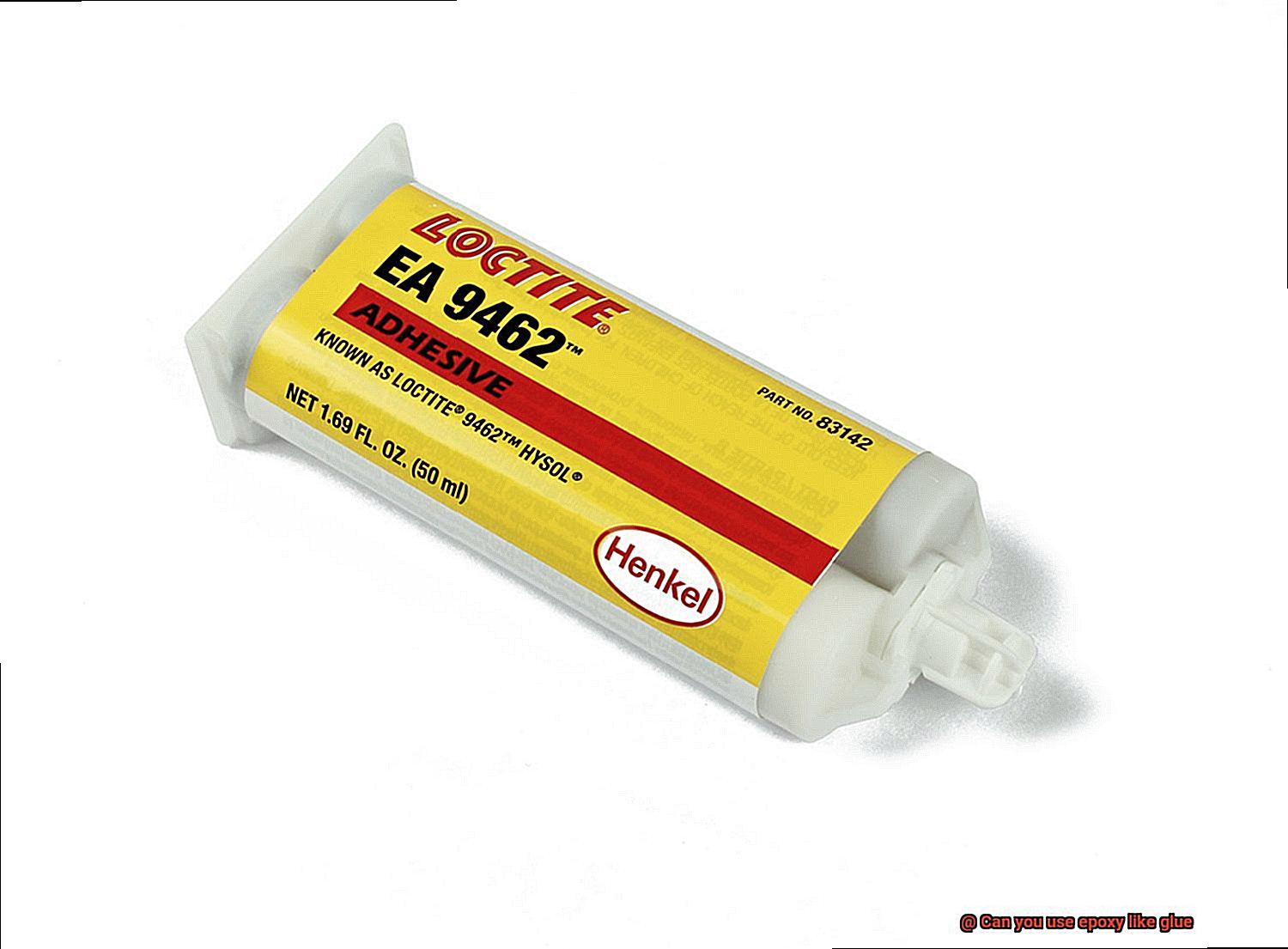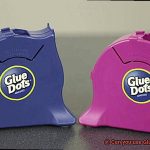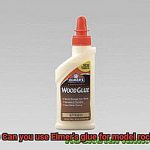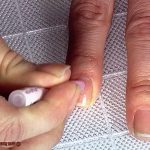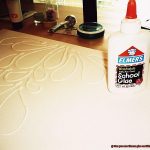Are you a DIY enthusiast or someone who loves fixing things up? If so, then you’ve probably heard of epoxy. This adhesive has gained popularity over the years for good reason – it’s incredibly versatile and strong.
But can epoxy be used like glue? It’s a common question that many DIYers ask, and the answer isn’t always straightforward. In this blog post, we’ll explore the various uses of epoxy and how it can be an excellent substitute for traditional glue.
We’ll also delve into the differences between epoxy and glue, including their advantages and disadvantages. Plus, we’ll cover which surfaces are suitable for using epoxy on.
Before we get into all the technical details, let’s take a step back and learn about the chemistry behind epoxy and why it’s such a unique adhesive. Did you know that epoxy is a thermosetting polymer? That means when it’s mixed, it undergoes a chemical reaction to form a strong and durable bond. This sets it apart from traditional adhesives that typically dry or cure through evaporation.
So, if you’re curious about using epoxy in place of glue or want to add this versatile adhesive to your DIY toolkit, keep reading.
What is Epoxy?
Contents
- 1 What is Epoxy?
- 2 Advantages of Using Epoxy as Glue
- 3 Disadvantages of Using Epoxy as Glue
- 4 When Should You Use Epoxy Instead of Traditional Glue?
- 5 How to Use Epoxy as an Adhesive
- 6 Tips for Working with Epoxy
- 7 Common Mistakes People Make When Using Epoxy
- 8 Alternatives to Using Epoxy as an Adhesive
- 9 Conclusion
Epoxy is a remarkable two-part adhesive that has become the go-to choice for professionals in need of a strong and durable bond. Composed of a resin and hardener that are mixed together at a specific ratio, epoxy produces a powerful chemical reaction that results in an unbreakable bond.
Recognized for its versatility and strength, epoxy can bond an array of materials, including metal, wood, plastic, and glass, making it a popular choice for both industrial and heavy-duty applications. Its impressive resistance to heat and chemicals also makes it a reliable option for harsh environments.
This versatile adhesive comes in various forms, including liquid, paste, and putty, providing endless possibilities for use. Whether it’s filling gaps or sealing surfaces, or even as a coating, epoxy can be applied to enhance the aesthetic appeal of the finished product. Moreover, it is available in different colors or can be tinted to match the material being bonded or coated.
However, it’s essential to note that epoxy doesn’t always substitute traditional glue. It takes longer to cure than glue and necessitates more preparation and mixing before application. Additionally, once it’s applied, removing or adjusting it can be more challenging.
Therefore, when deciding whether to use epoxy or traditional glue, one must consider the materials being bonded and the conditions they will face. Generally speaking, epoxy is an excellent choice for bonding materials that require a strong and durable bond, while glue may be better suited for lighter-duty applications.
Advantages of Using Epoxy as Glue
This two-part adhesive is a favorite of both DIY enthusiasts and professionals, and for good reason. With its many superior qualities, there are plenty of advantages of using epoxy as glue.
One of the biggest advantages of epoxy is its strength. This adhesive is one of the strongest available on the market. It can bond a wide variety of materials, from wood to metal to plastic and ceramics. The bond created by epoxy is so strong that it can withstand heavy loads and resist vibrations, making it perfect for use in industrial and construction applications.
Epoxy is also highly waterproof. It’s resistant to water, making it a go-to adhesive for sealing cracks and gaps in plumbing fixtures, boats, and swimming pools. Whether you’re working in a humid or wet environment, epoxy has you covered.
In addition to being waterproof, epoxy is also highly resistant to chemicals such as acids, bases, and solvents. This makes it an excellent choice for industrial applications where exposure to harsh chemicals is common.
Another advantage of epoxy is its versatility. It can be used on a wide range of surfaces including porous and non-porous materials. And, it’s not just limited to bonding – epoxy can also be used for filling gaps, repairing cracks, and creating a smooth surface.
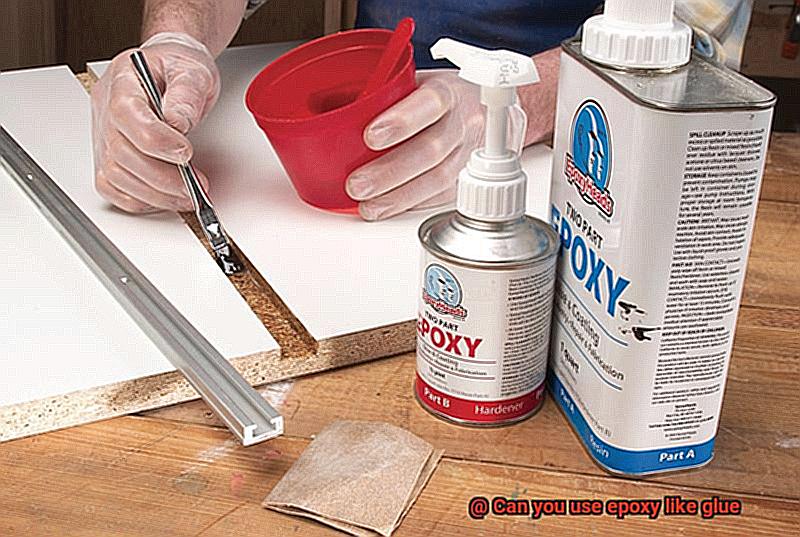
Last but not least, epoxy is incredibly durable. It can last for years without deteriorating or losing its strength, making it an ideal adhesive for projects that require long-term bonding.
Disadvantages of Using Epoxy as Glue
Epoxy is a popular choice for adhesive due to its strength and durability. However, it’s essential to consider the downsides before deciding on it as your go-to glue.
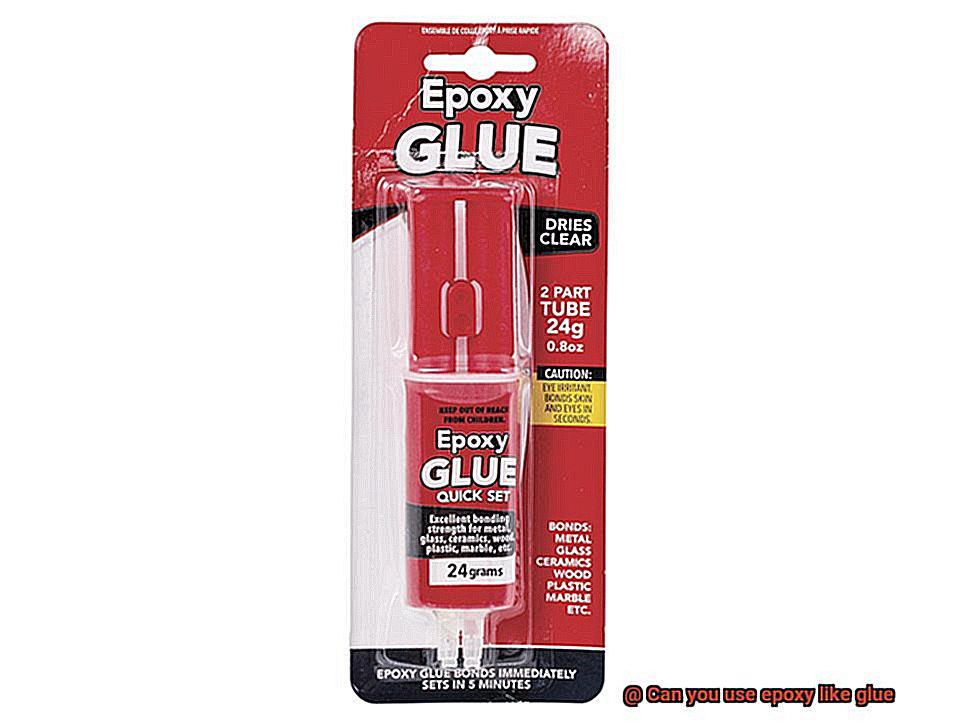
One major disadvantage is the long curing time of epoxy. Unlike other adhesives that dry quickly, epoxy can take several hours to cure fully. This means you may have to wait a while before handling or using the bonded objects. Patience is a virtue when using epoxy.
Another downside of epoxy is its sensitivity to temperature and humidity. If exposed to extreme temperatures or high humidity levels, the bond could become brittle and weak over time, leading to bond failure. This makes it less ideal for outdoor projects or in regions with high humidity levels.
In addition, epoxy can be difficult to work with as it requires precise mixing of the resin and hardener components to achieve the desired strength and consistency. If mixed incorrectly, the bond may not form properly or may even be weaker than expected. This can be frustrating for those without experience working with this adhesive.
Lastly, epoxy can be expensive compared to other types of adhesives. This makes it less practical for those who only need to bond objects occasionally or for small projects.
When Should You Use Epoxy Instead of Traditional Glue?
Firstly, epoxy is the epitome of durability. It creates a robust and long-lasting bond that can withstand harsh environmental factors, extreme temperatures, and even chemical exposure. In contrast, traditional glue may weaken over time due to exposure to environmental factors, making it less reliable in the long run.
Secondly, if you’re dealing with repairs that require a tight fit between surfaces being bonded, traditional glue might not be your best bet. In contrast, epoxy can fill gaps and cracks between surfaces, making it the ideal adhesive to fix ceramics, glass, and metal objects that may have cracks or chips.
Thirdly, when it comes to structural bonding, epoxy is the way to go. Its high tensile strength makes it capable of holding heavy loads and withstanding stress without breaking. It’s no wonder that epoxy is commonly used in construction and engineering projects where a strong, structural bond is required.
However, before committing to epoxy as your go-to adhesive, it’s essential to consider its downsides. Epoxy has a longer curing time than traditional glue and can be sensitive to temperature and humidity. Moreover, it requires precise mixing requirements and can be relatively more expensive than other adhesives.
How to Use Epoxy as an Adhesive
Epoxy is a versatile adhesive that can be used in a variety of applications, including bonding different types of materials together. However, using epoxy as an adhesive requires some preparation and careful handling to ensure the best results. Here are five sub-sections to consider when using epoxy as an adhesive:
Surface Preparation
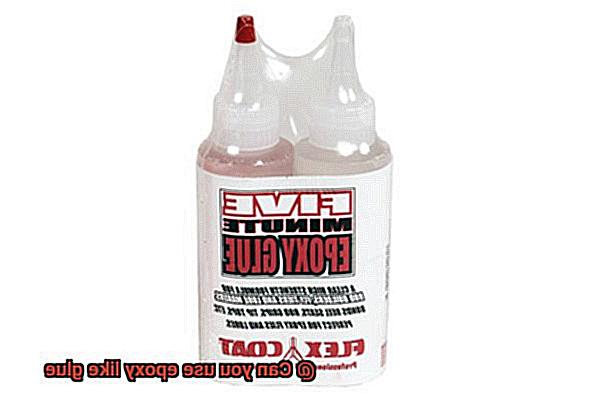
The first step in using epoxy as an adhesive is to prepare the surfaces that will be bonded together. The surfaces must be clean, dry, and free of any debris or contaminants that could interfere with the bonding process. This can be done by wiping the surfaces with a clean cloth and a solvent such as acetone or alcohol. Proper surface preparation is essential for achieving a strong and lasting bond.

Mixing Epoxy
Next, the two parts of the epoxy adhesive must be mixed together in the correct ratio according to the manufacturer’s instructions. This is usually done by squeezing equal amounts of each component onto a mixing surface and then stirring them together thoroughly. It is important to mix the epoxy thoroughly to ensure that it cures properly and creates a strong bond.
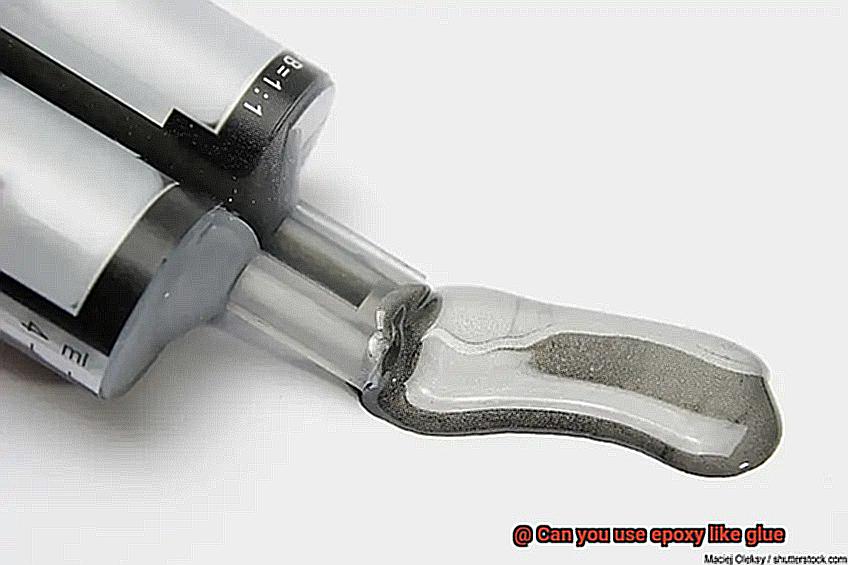
Applying Epoxy
Once the epoxy is mixed, it should be applied to one of the surfaces that will be bonded together. The epoxy should be spread evenly over the surface, taking care to cover all areas that will come into contact with the other surface. If necessary, the epoxy can be spread using a small brush or spatula. Be sure to apply enough epoxy to create a strong bond, but not so much that it oozes out from between the two surfaces.
Pressing Surfaces Together
After the epoxy has been applied to one surface, the two surfaces should be pressed together firmly. It is important to apply even pressure across the entire surface to ensure a strong bond. Any excess epoxy that squeezes out from between the surfaces can be wiped away with a clean cloth or scraped off with a tool.
Curing Epoxy
Finally, the epoxy should be allowed to cure according to the manufacturer’s instructions. This may involve leaving it to dry at room temperature for several hours or applying heat to speed up the curing process. It is important to allow the epoxy to cure fully before subjecting the bonded surfaces to any stress or pressure.
Tips for Working with Epoxy
This versatile adhesive can be used for a variety of applications, but it’s important to follow some key tips to ensure a successful outcome. Here are five tips for working with epoxy:
Surface Preparation is Key
Before applying epoxy, prepare the surface properly. It must be clean and free of any dirt, dust, or grease. Sanding the surface with fine-grit sandpaper creates a rough texture that will help the epoxy adhere better.
Mix Epoxy Accurately
Epoxy is a two-part resin system that requires accurate mixing before use. Follow the manufacturer’s instructions precisely when combining the two parts. Use a measuring cup or scale to ensure accuracy, as mixing too much or too little can result in an incomplete cure.
Apply Epoxy Evenly
To avoid air bubbles and drips, apply epoxy evenly and in thin layers. Use a brush or roller to spread the epoxy, and use a scraper to remove any excess. Remember not to apply too much or too little, as this can impact the strength of the bond.
Work in a Well-Ventilated Area
Epoxy can produce harmful fumes when curing, so work in a well-ventilated area or wear a respirator mask. This will protect you from inhaling any dangerous fumes.
Give Epoxy Time to Cure
Allow sufficient curing time as specified by the manufacturer before handling or sanding the epoxy. Rushing this process can weaken the bond and make your project less durable.
Common Mistakes People Make When Using Epoxy
Epoxy is a versatile adhesive that has a wide range of applications, from DIY projects to industrial use. However, even seasoned professionals can make common mistakes when using epoxy, which can lead to weak bonds, air bubbles, or uneven surfaces. These errors can be costly and time-consuming to fix. That’s why it’s essential to learn about the most common mistakes people make when using epoxy.
The first and most crucial mistake is not measuring the components correctly. Epoxy consists of two components: the resin and the hardener. It’s crucial to measure both components accurately and mix them thoroughly to get a strong bond. Eyeballing the measurements or not following the instructions carefully can lead to an improper mix and weak bonds.
The second mistake is rushing the application process. Epoxy takes time to cure properly, and applying a second coat before the first coat has cured can result in a chemical reaction that creates air bubbles. Additionally, applying epoxy in humid or cold conditions can also lead to air bubbles, uneven surfaces, or discoloration. It’s essential to be patient and give your epoxy enough time to cure.
The third mistake is applying epoxy on dirty or greasy surfaces. Epoxy needs a clean and dry surface to bond correctly. Applying epoxy on a dirty or greasy surface can prevent it from adhering properly and weaken the bond over time. It is essential to prep the surface thoroughly by cleaning it with alcohol, sanding it lightly, and wiping it clean before applying epoxy.
The fourth mistake is not using protective gear. Epoxy contains harmful chemicals that can irritate the skin and eyes. Not using protective gear such as gloves, goggles, or respirators can lead to health issues and accidents.
The fifth mistake is overusing epoxy. Using too much epoxy can lead to waste and messiness. It’s essential to apply epoxy sparingly and evenly to get a clean and strong bond.
Alternatives to Using Epoxy as an Adhesive
When it comes to adhesives, epoxy is often the first choice due to its strong bonding properties. However, there are times when you may need to explore other options. Whether you’re looking for a more eco-friendly option, need a faster drying time, or simply want to try something new, there are several alternatives to using epoxy as an adhesive.
One popular alternative is cyanoacrylate glue, commonly known as super glue. This type of adhesive dries quickly and forms a strong bond between materials such as plastic, metal, and wood. It’s also water-resistant and can be sanded or painted over once it has dried. However, cyanoacrylate glue can be brittle and may not hold up well under stress.
If you need an adhesive that fills in gaps or imperfections, polyurethane glue might be the way to go. This type of glue expands as it dries, creating a tight bond between materials. It’s waterproof and can be used on a variety of surfaces, including wood, metal, and plastic. Keep in mind that polyurethane glue requires moisture to cure properly and may take longer to dry than other types of adhesives.
For those looking for eco-friendly options, plant-based adhesives are a great choice. Soy-based adhesives are made from soybeans and contain no toxic chemicals or solvents. They can be used on a variety of materials including wood, paper, and cardboard. Other plant-based adhesives include starch-based glues and natural rubber adhesives.
In addition to these alternatives, there are also specialized adhesives available for specific applications. Hot glue guns are commonly used in crafting projects and can bond materials such as fabric and foam. Welding is another option for bonding metal materials together.
Conclusion
In conclusion, epoxy is a versatile adhesive that can serve as an excellent alternative to traditional glue for a wide range of applications. Its exceptional strength, durability, and resistance to water and chemicals make it ideal for heavy-duty industrial projects.
However, it’s important to keep in mind that epoxy has a longer curing time than other adhesives and requires precise mixing. Additionally, it tends to be more costly than other options.
To achieve a strong bond with epoxy as an adhesive, proper surface preparation and accurate mixing are essential. Furthermore, working in a well-ventilated area and allowing sufficient curing time before handling the bonded surfaces is crucial.
While epoxy is often the preferred choice due to its superior bonding properties, there are various alternatives available such as cyanoacrylate glue, polyurethane glue, plant-based adhesives, hot glue guns, and welding.
Whether you’re an avid DIY enthusiast or a professional in need of a dependable and robust bond for your project, epoxy can be an excellent substitute for traditional glue.

